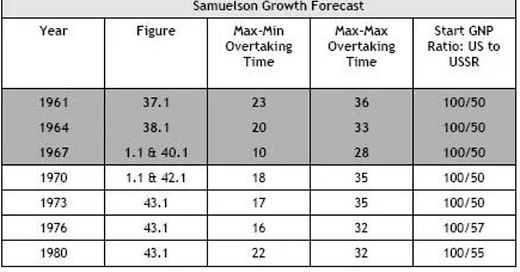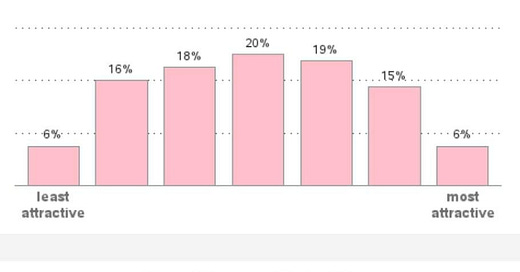
When I was in Econ 1, we actually used the infamous 1989 Samuelson text – the one that said, “the Soviet economy is proof that, contrary to what many skeptics had earlier believed, a socialist command economy can function and even thrive.” So I was delighted when my colleague David Levy and his co-author Sandra Peart decided to put Samuelson’s Sovietology under a microscope.
Back in 2006, they published some preliminary findings; now we can see Levy-Peart’s full story. Quick version: Samuelson habitually overestimated Soviet growth, edition after edition. Here’s a nice table summarizing the numbers relayed to millions of students over the decades:
Levy-Peart find that Samuelson was hardly alone. Successive editions of competing textbooks were also stubbornly high on the USSR:
What we find repeatedly is over-confidence in the potential for Soviet growth and an asymmetric response to past forecast errors. More than this, the textbooks report faster Soviet income growth combined with a constant ratio of Soviet-US income. This trust in the future and skepticism about the past was the basis of a standard Soviet-era joke: “Under Communism, the Poles are fond of saying, only the future is certain; the past is always changing.”
When Levy first presented this evidence, he gave it an anti-elitist spin. The problem, he said, was that we put too much trust in experts, and not enough in Soviet anecdotes. I demurred. The real problem, I said, was left-wing bias. Samuelson and other mainstream Keynesians were socialists at heart, so they bent over backwards to be “fair” to their ugly cousins behind the Iron Curtain.
In the latest draft, Levy-Peart try to distinguish between these competing hypotheses, and wind up standing by their original position. They create a 2×2 textbook matrix. Ideology (liberal vs. “neutral”) is on one axis; methodology (“thick model” vs. “thin model”) is on the other.
If I understand Levy-Peart correctly here (and I’m not sure I do), they link trust in experts to the thin model, and egalitarian respect for the man in the street to the thick model. In any case, they conclude that:
If the overstatement of Soviet growth was mainly driven by ideology we would expect Samuelson, Tarshis and Heilbroner to overstate Soviet growth more dramatically than McConnell and Bach. They did not. If the problem arose primarily because of the use of thin models, Samuelson and McConnell would overstate Soviet growth more dramatically that the other texts. This is what we have observed above.
They may have a case, but I’d like to see Levy-Peart expand their universe to include full-blown right-wingers. If you sampled all economists writing about the Soviet economy in, say, 1970, what would be the stronger predictor of negative assessments — ideology or elitism? I bet that in a decent multiple regression, ideology would crush elitism. Alas, I don’t know enough about the data even to specify a decent bet, but I’m more than open to one.
P.S. If you want to find one thinker who analyzed the Soviet economy using Production Possibility Frontier diagrams without becoming a Soviet dupe, see the article on “Communism” in The Concise Encyclopedia of Economics. 🙂
The post appeared first on Econlib.


















The relative levels of Soviet and US GNP's used by Samuelson were conventional wisdom at the time. The base for the comparisons was Abram Bergson's work for [not in] 1955. After that there was a CIA cottage industry manufacturing Soviet GNP's. Relative to US GNP, the growth rates implied were not absurd, and even showed a falling back from time-to-time.
What was scientifically missing from all this was the extrapolation of growth rates. Rebuilding postwar is quick and cheap for any society, but catch-up is more interesting. But that wasn't understood in 1970, or even 1980. A quick and dirty perusal of per capita growth rates in Western Europe vs the US today shows that catch-up has even seemed to stop there.
Yes, these guys were all lefties, but I think more fundamentally there was a lack of understanding, a theory deficit, in other words.
To put into a different perspective: I know of no economist who saw the Soviet Union crumble before their [our] very eyes by the late 1980's at the latest.
The Soviet forecasts were based on "actual" statistics that were lies. Why does this post not mention that the "actual" statistics were false?